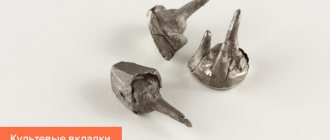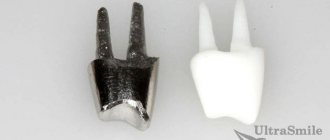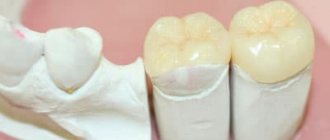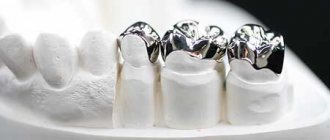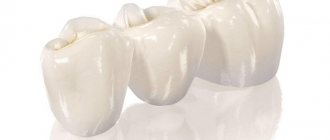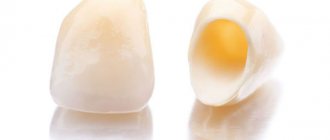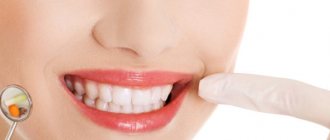A stump inlay is a microprosthesis, which is a tooth stump made of metal, ceramics or zirconium dioxide. It is used when there is significant destruction of the crown part of the tooth and the root is intact. The prosthesis fills the resulting void and creates a support on which an artificial crown is placed. Before installing the inlay, the tooth must be depulped.
A tooth stump inlay is a reliable prosthetic method. With a well-sealed canal and the choice of high-quality materials (for example, gold), it lasts up to 15–20 years.
At the Mitino Dental Center you can get advice from a qualified orthopedic dentist, as well as perform any type of dental prosthetics.
General information about designs
Zirconium dioxide inlay - what is it? You need to understand that inlays in dentistry belong to the field of prosthetics, or more precisely, microprosthetics. That is, these are small-sized prostheses, which come in 2 types:
- restorative (or coronal): independently restore the integrity of the tooth,
- stump (or pin): serve as a support for another prosthesis - a crown, bridge, removable orthopedic structure.
Both restorative and pin inlays are made from zirconium oxide1 - we will describe below what each of these zirconium inlays is and what it looks like. It is worth noting that zirconium dioxide is a very strong material in compression and bending (more than 1400 MPa), in this it can even be compared with metal alloys. However, zirconium dioxide is more often called ceramics - more precisely, metal-free ceramics, since purely externally the material is white, like your own teeth.
Zirconium dioxide crown on an implant for all 55,000 rubles instead of 80,000 rubles!
OSSTEM implant (South Korea), individual zirconium abutment, gum former, impression taking.
Creation of a Prettau zirconium crown using 3D modeling technology. Consultation with 2 doctors: an orthopedist and an implantologist for free! Call now or request a call
Opening hours: 24 hours a day - seven days a week
Single-channel and multi-channel tabs
If the tooth is multi-rooted, then the question arises: should I make a solid core inlay or a collapsible one? If the channels run parallel, solid blanks can be used. It is possible to determine how to proceed further only if the doctor has photographs of your tooth and sees how the canals pass. Some experts, in addition to standard diagnostic methods, recommend doing a CT scan. With the help of computed tomography you can see:
- condition of the root part;
- shape of root canals;
- the presence of periodontal and bone pathologies that require treatment. After all, you may have a cyst under your root that you didn't know about.
Overall, a multi-root stump is an excellent solution. Being held in several channels at once, it creates an even load on the entire tooth, is securely held and ensures that the root does not break. A crown based on such an inlay can be attached to a bridge without fear of damage or destruction.
Restorative microprostheses - features and advantages
Restorative inlays made of zirconium dioxide are small-sized microprostheses. They are fixed on a natural dental crown, provided that it is destroyed by no more than 50%. You can compare restorative ones with fillings (only very strong ones). Because both are installed in a dental cavity cleared of caries and restore the integrity of the tooth. However, if the filling is formed directly in the tooth during 1 visit to the clinic, then the microprosthesis is made only in the laboratory using impressions (casts) taken in advance.
In most cases, restorative ones are installed on the chewing surfaces of the teeth in the lateral sections of the row - on premolars (“fours” and “fives”) and molars (“sixes”, “sevens”, less often - on “eights”, i.e. wisdom teeth) . In size, microprostheses can be small - inlay, or almost completely cover the top of the crown along with chewing tubercles or cutting edges - onlay, overlay, pinlay varieties.
How to fix zirconium: APC concept
Some of the new materials introduced recently have had a huge impact on the development of the entire clinical dentistry, greatly helping to improve existing restorative treatment concepts.
Ceramics based on zirconium dioxide (ZrO2), in turn, have significantly expanded the possibilities of using all-ceramic restorations both in cases of restoration of single teeth and in the course of total rehabilitation of dental patients supported by implants. The first zirconia coping produced by CAD/CAM technology (although it would be more accurate to call it yttrium-stabilized zirconia or yttrium-stabilized zirconia tetragonal polycrystalline [Y-TZP] coping) was introduced in the late 1990s, thus marking , a new era of aesthetic rehabilitation with zirconia-ceramic restorations (PFZ).
First, Nobel Procera Zirconia (Nobel Biocare) material appeared on the market and a little later in the 2000s, LavaTM Zirconia (3M ESPE). The demand for zirconium-ceramic restorations increased due to their unique highly aesthetic characteristics, as well as due to the high bending strength of zirconium, the parameter of which reached more than 1000 MPa. Early studies of new restorations, however, often reported high rates of chipping and fracture of the veneering material, especially in veneer cases. As a result of subsequent improvements in the physical properties of the material, zirconium-ceramic structures were improved so much that the long-term performance of their use was almost no different from that of metal-ceramic crowns.
However, given that there were still some concerns about ceramic chipping, and the sintering process was very, very sensitive, monolithic all-zirconium restorations produced by CAD/CAM milling became extremely popular as an alternative. It is logical that in the manufacture of such, the need to use facing ceramics simply disappears.
The advantages of all-zirconium crowns are the cost-effectiveness and speed of manufacturing these structures compared to multilayer indirect restorations; in addition, the transparency parameters of second-generation zirconium materials have apparently improved compared to the first, without compromising the flexural strength indicators. However, to achieve individual shades, at the green stage of milling or before sintering, a liquid dye must be applied to the workpieces, and after sintering, the external coloring of the structure must also be provided. To simplify this process, some manufacturers have developed pre-colored zirconia blanks in a variety of shades, some of which have separate shade parameters for enamel and dentin, helping them better mimic the appearance of natural teeth. However, even multilayer zirconia restorations can be color modified to provide an external color or a similar result can be achieved by polishing to the desired level of gloss.
The latest generation of zirconium materials is characterized by a significantly greater degree of translucency, providing improved aesthetics of restorations, which is extremely important for the prosthetic rehabilitation of the anterior areas of the teeth. The increased degree of translucency of the materials is achieved through small changes in yttrium (Y2O3) in the composition of the preform (5 mol% or more instead of the usual 3 mol%), which is essentially used to stabilize the tetragonal phase of zirconia, resulting in the formation of more particles in cubic phase. Cubic zirconium provides significantly greater light transmission of the material, but at the same time reduces its physical resistance. The bending strength of highly transparent workpieces ranges from 550-800 MPa, depending on the degree of translucency: the higher the translucency parameter, the lower the bending strength. But despite some problematic aspects, the specific properties of zirconia make it a reliable and promising alternative for use in the practice of aesthetic dentistry, especially in the manufacture of veneers and onlays, provided an adequate bonding protocol is ensured.
Bonding ceramics
Ceramic materials are brittle and cannot undergo plastic deformation, which is characteristic of metal alloys. Thus, their elastic modulus and functional stress behavior differs from metals: the crystalline structure compromises crack propagation when the outer surface is damaged and excess loads are applied. Thus, the type of luting agent, as well as the luting technique itself, significantly influences the clinical success of all-ceramic restorations. Adequate treatment of the supporting tooth stump, as well as sufficient bonding strength of the composite material, promote retention of ceramic restorations, reduce the risk of microleakage, and also increase the parameters of their resistance to possible destruction during operation. Clinical procedures and pretreatment steps for material and tooth surfaces differ depending on the composition and mechanical properties of the ceramic substrate. The two main types of ceramic materials remain those based on silica (i.e., feldspathic, leucite and lithium disilicate ceramics), as well as those without the presence of silica in their structure. The latter include materials based on aluminum oxide and zirconium oxide. The quality and durability of the bond between the composite and the ceramic surface remains a key aspect to ensure the clinical success of such restorations. These, in turn, depend on the surface topography of the ceramic base and its chemical interaction with the composite cement. As with any other adhesive bond, contamination at the material interface will negatively impact the long-term performance of esthetic crowns. To treat the glassy matrix of ceramics, it is recommended to use hydrofluoric acid and a binding agent - silane. The first component selectively dissolves the glass matrix and allows the formation of a porous, uneven ceramic surface with an increased wettability parameter. The use of silane after etching helps to increase adhesion through improved mechanical adhesion and the formation of silicon compounds (silicon oxides) in the structure of the organic matrix of polymer materials through siloxane bonds. It is not advisable to treat the inner surface of silicon-based ceramics using surface abrasive methods, such as air abrasion or grinding, since such approaches can provoke the occurrence of microcracks, which subsequently lead to fractures of the ceramic structure.
High-strength metal oxide ceramics such as alumina and zirconia are generally only considered “cementable” due to their high flexural strength, which exceeds typical masticatory loads. Thus, crowns and bridge structures with adequate retention parameters and the required thickness of ceramic material can be fixed in the most conventional way. It is optimal for such purposes to use resin-modified glass ionomer cement or its self-adhesive analogue, since approaches using these materials are both the least time-consuming and optimally accessible. In this case, you should strictly follow the manufacturer’s instructions, since some of them require air-abrasive treatment of the ceramic surface, while others, on the contrary, do not recommend it. Some self-adhesive cements must first be spot-exposed, then proceed to remove excess material, and only then carry out final polymerization. It is also important to remember that before bonding, each indirect restoration should be cleaned in an ultrasonic bath using ethanol or acetone.
APC concept for zirconium bonding
So-called “cemented” zirconium restorations are characterized by a number of problematic aspects, including insufficiently reliable structural strength, problems with adhesion to the composite, and lack of sufficient retention. All this makes the doctor think about what is better to choose in certain situations: solid crown designs or vestibular veneers. The success of bonding restorations depends on the adequacy of the choice of the required material, the necessary processing of the tooth stump and the inner surface of the restoration. Tooth surface treatment should be carried out strictly according to the manufacturer's protocol and only with the use of dentin bonding agents, since most self-etching bonds form too thick a film during photopolymerization. Research into the bond quality between composites and ceramics has been conducted over the past two decades. Classic articles by Kern and colleagues demonstrate that for high-strength ceramics, most of the available bonding protocols provide treatment success only in the short term, while long-term results can only be achieved through preliminary air-abrasive treatment followed by the use of composite cement, which must contain special phosphate agents. monomers like 10-methacryloyloxydecyl dihydrogen phosphate (MDP monomer). Some of the known composite cements have been developed specifically to provide adhesion to the metal coping of the restoration. The first studies on the issue of bonding to aluminum and zirconium began in the 2000s, and included the testing of thousands of known materials along with various protocols for treating the surface of abutment teeth. Unlike other studies that used polished ceramic specimens, we analyzed the actual internal surfaces of CAD/CAM ceramic restorations and found that the use of phosphate monomers, such as MDP, in addition to composite cement helps to significantly improve bond strength and thus , achieve almost similar efficiency parameters for air-abrasive processing of high-strength ceramics. Other methods of processing structures such as acid etching and plasma spraying have also proven promising, but their use in everyday clinical practice is very, very limited.
In order to practically achieve a high-strength and durable connection of composite cement with zirconium, we recommend using the following three-stage algorithm, which for simplicity we call the “APC concept”: stage A (air particle) – air-abrasive surface treatment with aluminum oxide; stage P (primer) – stage of applying a special primer; Stage C (composite resin) - use of self-adhesive or dual-cure cement.
Stage A
After cleaning the restoration, the zirconia is treated by air abrasion using alumina powder or silica-coated alumina particles. Some authors call this procedure sandblasting or micro-etching. It is effective to use particles ranging in size from 50 microns to 60 microns at low pressures of up to 2 bar. The effect of this treatment is very important, since it simultaneously allows decontamination of the surface of the restoration. The results of this approach are widely highlighted in the literature and the use of smaller particles ultimately only allows for strengthening the structure without compromising its integrity in any way.
Stage P
This step involves the use of a special ceramic primer, which usually contains special adhesive phosphate monomers. The primer is applied to the surface of the zirconia. MDP monomer, which is also used in some dentin adhesives and some resin cements, has been shown to provide a more highly effective bond to metal oxides. In addition, such primers can also enhance the bonding abilities of other cements, such as glass ionomer-modified composites. An important aspect remains the need to use different materials from the same manufacturer, avoiding the use of cements and primers of different brands, which, most likely, also have different chemical compositions and, therefore, may be incompatible with each other. Some confusion arises when using special zirconia primers that contain silanes, which makes the latter universal materials applicable to various materials, including silica-based ceramics. In such cases, the main thing to remember is that these materials provide a long-term bond with metal-based ceramics only if they contain silica particles, or particles containing this chemical base.
Stage C
Self-curing or dual-curing cements are used to ensure an adequate level of material conversion under zirconia restorations that limit light exposure. But, on the other hand, the transparency of the zirconium structure is such that the shade of the cement fixing the crown still significantly influences the final aesthetic appearance of the restoration. Therefore, before final cementation, it is recommended to use special try-in pastes, which will help you choose the optimal shade of the fixing material. The APC concept is not limited only to the peculiarities of fixing zirconium structures on natural teeth, but can also be used in a dental laboratory for fixing supraelements supported on implants. For new products containing high levels of translucent zirconia with low flexural strength, the aspect of adequate bonding is even more critical because the thickness of such structures is significantly less than their standard counterparts. Veneers, inlays, onlays or prostheses can only guarantee long-term functioning when the stage of their adhesive fixation was carried out strictly according to the protocol. The concept proposed by APC is not new, but is the result of twenty years of practice and testing of different adhesion protocols. The conclusions drawn from existing systematic reviews of the literature, which analyzed data from 140 different studies, are similar to those obtained at the end of this article, but the further search for methods to optimize the adhesion stage of zirconium restorations remains one of the most pressing tasks of modern dentistry.
Clinical case
A 40-year-old patient sought dental care with the chief complaint of cracked teeth and a desire to restore his previous habitual bite. During the dental examination, class I occlusal relationships and a slight discrepancy between teeth 8 and 9 were recorded. The patient also had a widespread form of pathological abrasion and class I mobility in the area of teeth 23-26. Carious lesions were found in the area of teeth 2, 4, 6, 8, 9 and 14, and wedge defects were found in the area of 4, 5, 10, 11, 13, 20 and 21. Photos 1-3 illustrate the clinical situation of the patient before treatment .
Photo 1. View of the patient’s smile: a compromising aesthetic situation.
Photo 2. Front view with maximum teeth closure before treatment.
Photo 3. View of the upper jaw before treatment.
As a treatment, the patient was offered a total rehabilitation protocol. The purpose of the complex intervention was to correct the erosive etiology of the lesions and protect the hard tissues of the tooth with the help of long-term restorations. The diagnostic wax-up guide was instrumental in determining functional and aesthetic treatment goals and shaping the anterior insertion path (Figure 4).
Photo 4. Diagnostic wax reproduction.
After periodontal treatment, restoration of carious defects and the use of provisional restorations, the doctor began the final preparation of the front teeth (photo 5) with their subsequent restoration.
Photo 5. Preparation of the upper anterior teeth to control the vertical parameters of occlusion.
CAD/CAM all-zirconium structures with a high degree of transparency (Katana UTML Ultra Translucent Multi-Layered, Kuraray Noritake Dental) were used as crowns (photos 6 - 7), which were cemented with self-adhesive composite cement (Panavia S.A., Kuraray Noritake Dental) .
Photo 6. CAD/CAM design of all-zirconium crowns in the area of the anterior teeth.
Photo 7. View of monolithic zirconium crowns on the model.
Photo 8 shows the situation after cementation of the anterior structures and gentle preparation of the posterior tooth area. For the distal supports, highly esthetic monolithic zirconium crowns and onlays were fabricated (Katana Zirconia UT, Kuraray Noritake Dental, photos 9-12).
Photo 8. Occlusal view of fixed zirconium crowns in the area of the anterior teeth. Conservative preparation of distal teeth for crowns and onlays.
Photo 9. Occlusal view of zirconium restorations in the posterior teeth.
Photo 10. View of the right zirconium restorations from the lingual side on the model.
Photo 11. View of the left zirconium restorations from the lingual side on the model.
Photo 12. Monolithic zirconium onlays and crowns.
Restorations in the area of distal teeth were fixed according to the protocol of the APC concept. First, the structures were sandblasted with 50 µm aluminum oxide particles at a pressure of 1.5 bar (photo 13), after which a special ceramic primer (ClearfilTM Ceramic Primer, Kuraray Noritake) with adhesive phosphate monomer (MDP) was applied (photo 14).
Photo 13. ARS concept: stage A - air-abrasive treatment with aluminum oxide particles of 50 microns at a pressure of 1.5 bar.
Photo 14. APC concept: P stage - application of a primer with active phosphate monomers.
Isolation of the working field was carried out using cotton rolls and retraction thread, since the use of a rubber dam was difficult in this clinical situation. The enamel of the abutment teeth was selectively etched (Figure 15) using 35% phosphoric acid (K-Etchant Gel, Kuraray Noritake Dental), and the dentin was conditioned using (Figure 16) a self-etching dentin primer (Panavia V5 Tooth Primer, Kuraray Noritake Dental). Dual-curing composite cement (Panavia V5 Paste Universal, Kuraray Noritake Dental) was dispensed directly onto the restoration using a special syringe mixer.
Photo 15. Selective etching of the enamel of abutment teeth with phosphoric acid for 20 seconds.
Photo 16. Application of self-etching dentin primer.
After planting the structures, excess cement was removed (photos 17 - 18), and only after that complete polymerization was carried out (photo 19). The appearance of the teeth after the end of treatment is shown in photos 20-22.
Photo 17. APC concept: Stage C - application of dual polymerization composite cement. Installation of restoration and removal of excess cement.
Photo 18. Removal of excess cement from the proximal sides.
Photo 19. Polymerization of the material for 60 seconds on each side.
Photo 20. Occlusal view of restorations on the upper jaw.
Photo 21. View of restorations in a state of maximum closure of teeth.
Photo 22. View of the patient’s smile after treatment.
conclusions
Reliable cementation protocols, as well as the materials used for them, are the basis for achieving long-term clinical success of indirect ceramic restorations, including those based on zirconia. The latter, thanks to their optical properties, provide the most adequate aesthetic result of treatment in both the anterior and chewing teeth. Composite adhesion ensures retention of ceramic onlays, veneers and even dentures, and the systematic APC protocol, based on many years of research, helps achieve excellent long-term results of fixation of zirconia structures with composite cement. The algorithm consists of three simple steps: (A) - air abrasive treatment, (P) - application of zirconium primer and (C) - use of composite cement.
Authors: Markus B. Blatz, DMD, PhD Marcela Alvarez, DDS, MSD Kimiyo Sawyer, RDT Marco Brindis, DDS
Features of stump microprostheses
A stump or pin inlay, unlike a restorative one, is not an independent prosthesis. But it is used as a kind of microprosthesis, which is installed in the tooth under a crown or bridge. In essence, the stump is a support, and a very reliable one. The upper part of the stump is an analogue of a ground natural crown, and the lower part is analogous to miniature roots that are inserted into the root canals of the tooth.
Stump microprostheses can be one-piece or dismountable. Solid ones are installed in teeth with 1-2 roots, and collapsible ones are installed in teeth with 3 or more roots. After all, the canals in the roots diverge at different angles, and inserting a solid tab on three or four supports simply won’t work. If we consider single-channel and multi-channel tabs, then single-channel ones are always solid, and multi-channel ones can be either solid (for 2 channels) or collapsible (for 3 or more channels).
A prerequisite for prosthetics is if your own crown is destroyed by 70% or more, if only 1 wall is preserved, if the crown is completely broken at the root. But with all this, the roots must be healthy and intact. Stump zirconium inlays are placed on both the front and chewing teeth.
What is a core inlay for a crown?
A stump inlay is an orthopedic structure that serves as a support for installing an artificial crown on a severely damaged tooth. This prosthetic element is also called a pin stump inlay, since its root part resembles a dental pin. It is inserted into the dental root canal, and a crown is placed directly on the coronal tip of the inlay, similar to the stump of the prepared tooth. The post-stump inlay should not be confused with a regular dental inlay, which is used as an alternative to fillings.
Advantages of using stump tabs
- The core inlay is made according to individual impressions of the patient and completely reproduces the space of the canals of the tooth to be restored with a crown.
- The stump inlay also has an upper part - in the shape of a tooth ground for a crown. This structure of the microprosthesis ensures uniform load distribution even under strong pressure while chewing food.
- The core tab may have several pins to restore a multi-rooted tooth.
Advantages of microprostheses made of zirconium dioxide
If the question arises, which is better - a zirconium restoration inlay or a filling, then the first has the following advantages:
- more reliable: it is made of the strongest zirconium dioxide, and the filling is made of liquid composite or cement. In the future, these factors seriously affect the service life,
- more durable: a microprosthesis made of zirconium dioxide can last more than 20 years, and a large filling - on average 3-5 years, maximum about 7 years,
- tighter fit to the walls of the cavity: the microprosthesis is created in the laboratory using special equipment, and in exact accordance with the dimensions of the cavity - therefore it adjoins it without gaps. And over time, the tab, unlike a filling, does not peel off from the walls,
- does not wear off or sag during use: let us remind you that the material is extremely durable, which cannot be said about the filling - it begins to wear out and sag within a year after installation.
There are 2 moments when the filling wins. The first is if the cavity is very small, i.e. the microprosthesis will not be qualitatively fixed in it. The second is the front teeth, since they have a very thin cutting edge instead of an extensive chewing surface (like premolars and molars). More often, front teeth with small defects are restored with fillings or veneers - they, by the way, can also be made of zirconium dioxide. Restorative (pinlay varieties) in some cases can be placed on the lingual surface of an incisor or canine.
Patients often ask which inlays are better – fiberglass or zirconium? You need to understand that the fiberglass pin is not a tab, but a thin rod (just like a metal pin). Let's see what important advantages zirconium dioxide core inlays have over conventional pins:
- made individually for the patient, so they fit tightly to the root canals,
- very durable: while fiberglass pins are less durable, metal pins are thinner, so they often break,
- do not shine through the prosthesis: because are white in color, and the metal pin is visible through the filling material,
- qualitatively transfer the load to the root and jaw bone due to the anatomical shape of the microprosthesis,
- serve for about 15-10 years: and the maximum service life of a conventional pin is 5 years, because it leads to overload and destruction of the tooth root.
Indications
As mentioned above, a zirconium core inlay is indicated for large or even complete tooth destruction; if thin walls remain, restoration is also possible, the main thing is the presence of a strong root that has been preserved.
If the root is lost 1-2 mm below the gum level, in some cases, inlays are used. By first performing an osteotomy
. All this is at the discretion of the doctor.
That is, indications for stump inlays for a crown are cases when:
- support for a crown or bridge is required;
- splinting of loose (moving) teeth due to periodontal damage;
- to remove a defect in the supragingival area;
- aesthetic correction of teeth (irregular shape, location).
What is known about the shortcomings
According to reviews from some patients, a zirconium inlay (restorative or stump) has only one drawback - its high cost. Another disadvantage is the time spent on prosthetics - it takes about 2 weeks to complete the treatment. Although, for example, CEREC technology allows you to make a restorative microprosthesis in 15-20 minutes - and it will be installed on the day you go to the clinic. However, such equipment is not available everywhere.
Read on the topic: what is CEREC technology - when does the dentist and patient need it, its pros and cons.
Another disadvantage is the pure white color of zirconium dioxide (several shades lighter than natural enamel) and its opacity. But dental technicians solve this problem by applying liquid ceramic, colored in the shade of enamel, to the upper part of the zirconium restorative microprosthesis. Or you can use alternative prosthetic options (more on them below).
What is the difference between a pin and a stump inlay?
The fundamental difference between a pin and a stump inlay is that it is placed under a filling. Previously, a similar technique was used to treat severely damaged teeth when it was not possible to install a crown. Subsequently, this method discredited itself with a large number of complications in the form of secondary caries. Moreover, detecting a carious process under an extensive filling on a pin was quite problematic. Often, such treatment led to severe damage to the tooth by caries and, as a consequence, to its removal.
Let's compare the disadvantages and advantages of the pin stump insert and the pin presented below:
Pros and cons of the stump Pros and cons of the pin
tabs
- a tight fit protects the tooth from pathogenic bacteria and the development of secondary caries;
- withstands significant chewing loads;
- has a long service life;
- does not require replacement in case of wear of the artificial crown.
- established in two visits to the doctor;
- involves significant grinding of living tooth tissue;
- costs more than a regular pin.
- costs less than stump inlays;
- installed in one visit;
- involves a smaller volume of preparation of living tooth tissue;
- unable to withstand the usual chewing load, over time the seal on the pin begins to collapse;
- the pin can be installed in only one dental canal;
- a loose fit allows bacteria access into the dental cavity, which provokes the appearance of secondary caries;
- lasts no more than 2-3 years.
Answering the question “Which is better - a stump inlay or a fiberglass pin,” most experts are inclined to favor dental inlays. Considering the unreliability of installing a filling on a pin, such a service can be found extremely rarely in modern dentistry. The most correct option would be to use a stump tab and then install a crown on it. The choice is due to the fact that this microprosthesis not only strengthens the crown, but also protects the tooth from further destruction throughout life.
Indications for prosthetics
Restorative and core microprostheses made of zirconium dioxide are indicated for installation in adult patients, less often - in adolescents with permanent teeth (such prosthetics are not performed on dairy patients). Let's look at the readings in more detail in the table below.
| Factor | Restorative microprostheses | Stump microprostheses |
| Installation location | On a natural crown | To the root canals |
| Initial preservation of the natural crown | 50% or more | Less than 70% or complete destruction to the root |
| Root condition | Healthy, no cracks, cysts or granulomas | |
| Presence of dental nerve (pulp) | As a rule, the pulp should be healthy | Subject to mandatory removal, root canals are filled |
| What teeth are they placed on? | Mainly for chewing | Stump inlays can be placed under chewing and front teeth |
| Fixing another prosthesis on top | Not required | Mandatory |
When choosing a core microprosthesis made of zirconium dioxide and the patient wants to put a ceramic crown on the front teeth, the dentist can tell you why zirconium inlays are dangerous in this case. The aesthetics of the restoration will certainly be high. But the fragile ceramics of the crown will quickly become unusable - it will simply crack on a strong support. Therefore, it is better to give preference to a zirconium crown.
Don't know what type of prosthetics to choose?
We will help in the selection, advise where to read more information and compare types of prosthetics.
Consultation with an orthopedic doctor in Moscow clinics is free! Call now or request a call
Working hours: from 9:00 to 21:00 - seven days a week
Pros and cons of stump inlays
A significant advantage of these microprostheses is their high reliability and preservation of the anatomical structure of the tooth. The root is intact, so the dental unit receives full load when chewing. This means that the bone tissue of the jaw does not degrade, and normal bite and diction are maintained.
The installation procedure is minimally invasive and usually easy to tolerate.
Contraindications for installation
A contraindication to fixation of a restorative microprosthesis is extensive destruction of the natural crown. If, for example, more than half of it is missing due to caries or injury, or there is a very large cavity inside, surrounded by thin walls.
“I had a zirconium core inlay and the same crown made by my dentist. Probably 6 years have passed, but the tooth feels great and looks like a real one. Before this, I constantly had to change the filling - but in chewing ones, the fillings are large and not very beautiful, they fail over time.” Tatyana P., review from the woman.ru forum
It is contraindicated to install a stump if the dental nerve is preserved, if there are cracks in the root or if a pin/instrument fragment is stuck. Also considered a contraindication is the presence of inflammatory processes under the roots, formations (granulomas, cysts). It is also not recommended to install core microprostheses on teeth with pronounced mobility.
Making a core inlay for a crown
For the manufacture of stump pin inlays, direct and indirect methods are used. The direct method of manufacturing a stump insert has the following steps.
- After preliminary treatment of the tooth canals and its preparation for the stump inlay, the cavity is treated with Vaseline.
- The plastic, heated to a viscous state, is poured into a syringe and squeezed into the cavity through a wide needle to form an inlay.
- The pin is processed with the same material and inserted into the canal.
- After the plastic structure has hardened, the finished model of the inlay is removed from the cavity and sent to a dental laboratory for the manufacture of a microprosthesis from the material chosen by the patient.
The indirect method includes the following stages of manufacturing a stump inlay:
- After preliminary preparation of the tooth and canals, the doctor takes an impression and transfers it to the dental laboratory.
- The technician casts a plaster model and creates a prototype of the inlay from wax.
- Based on the wax sample, a metal stump inlay is made.
If we talk about stump inlays made of zirconium or ceramics, then CAD/CAM technologies are used for their production, which involve computer modeling of a microprosthesis, transferring the model to a milling machine and subsequent “cutting out” of the inlay from the workpiece.
How are dentures made and installed?
The processes of preparation for prosthetics, creation of a zirconium dioxide microprosthesis and its fixation consist of the following stages:
- Stage 1 – diagnosis: also at this stage, contraindications are excluded, the condition of the tooth itself, as well as neighboring and opposite ones, is studied,
- Stage 2 – preparation: the dentist-therapist removes all carious tissues, if necessary, depulps the tooth and fills the root canals, leaves a cavity for a classic restorative inlay or forms it inside the roots,
- Stage 3 – taking impressions (impressions): for example, using wax or silicone (this depends on the type of future prosthesis), the color of the restoration is selected. In clinics with modern equipment, digital impressions of the oral cavity can be made using an intraoral 3D scanner - this is fast, convenient and very accurate,
- Stage 4 – modeling: a real model of the prosthesis is created based on impressions in a dental laboratory, and a virtual model is created in a computer program based on digital impressions. But the real model will also need to be digitized and worked out in a CAD/CAM system for the next stage,
- Stage 5 – manufacturing: production occurs by milling on a machine, because the material is so strong that it will not be possible to create a prosthesis by hand. Usually the workpiece is made 20-25% larger than the actual size, because After milling, it is baked - in this case, the material “shrinks” to the required parameters. If necessary, the microprosthesis is covered with a layer of colored ceramics. Next, the product is sent to an orthopedic dentist,
- Stage 6 – fixation of the zirconium inlay into the patient’s tooth.
Installation steps
This type of prosthetics takes place in two stages - clinical and orthopedic. Orthopedic, in turn, is performed in stages.
Prosthetics begins with a consultation with an orthopedist. He decides on the possibility of using this method and agrees with the patient on all the details of the restoration.
Clinical stage
Performed in the dentist's office. A “living” tooth must be depulped and the canals filled. If the pulp is no longer present, an x-ray of the tooth is taken and the quality of the filling is checked. If it is bad, the channels are re-treated. This is a very important stage - the quality of canal filling determines how long your prosthesis will last.
Orthopedic stage
Takes place in the office of an orthopedic dentist:
- Using a drill, the doctor will unseal the upper part of the canal, into which the root part of the tab will go. A bed is created to accommodate it.
- An impression is taken of the patient's jaws.
- The impression is transferred to a technical laboratory, where dental technicians model and cast the prosthesis (or parts of it in the case of a collapsible design). If the innovative CAD/CAM method is used, the impression is scanned with a special device, the program creates a 3D model of the inlay, and then sends it to a milling machine, which turns it out.
- The orthopedist performs the final adjustment of the stump “on the patient.” Then it is secured in the canal with glass ionomer cement or composite material.
Then comes the next stage - installation of the crown. It follows the same algorithm: taking impressions, manufacturing and fitting.
Service life and care features
The service life of zirconium dioxide is very long - 15, 20 and even 25 years. Such long-term operation will depend both on the quality of preparation of the tooth for prosthetics and the accuracy of the fit of the orthopedic structure, as well as on compliance with the rules of wearing and caring for prostheses. What is needed for this? Do not forget about regular brushing of your teeth in the morning and evening, avoid hard and stretchy products (so that the denture does not come off). Ideally, you should also visit your podiatrist twice a year for a checkup.
The process of installing zirconium core inlays consists of the following steps:
- The tooth is prepared for an impression, the canals are treated, and excess tissue for prosthetics is removed.
- An impression of the cavity is made to form the future product.
- A workpiece is made from ZrO2, the model of which has previously been processed in CAD and CAM systems.
- Processing according to color and shape, preparation of appearance.
- Fixing the product in the patient's dental cavity.
These products differ in structure; they can be either collapsible or solid. In case of multi-channel teeth, the first type of prosthetics is used - root pins are installed, but this cannot be done in a one-piece structure.
Cost of prosthetics in Moscow and other cities
How much does a zirconium inlay cost? Its price is 18-20 thousand rubles. Moreover, prices in the capital and other cities are approximately equivalent, because the basis is the cost of the material (which is purchased from the same manufacturers or suppliers).
1Zinovenko O.G., Shinkevich M.V., Sadovskaya I.V. Aesthetic prosthetics using zirconium dioxide, 2014.
Author: Sambuev B. S. (Thank you for your help in writing the article and the information provided)
Manufacturing Features
To produce a product you must complete the following steps:
- inspection, taking wax impressions to obtain a model;
- turning is performed with a drill, the shape of the cavity is determined by the doctor;
- canal treatment, coating with antiseptic preparations;
- installation of a temporary filling while the inlay is being produced.
The next step is the production of the rod, for which a plaster model is formed by a technician. Using a special computer program, a three-dimensional model is created, which is used as a base for the manufacture of a zirconium inlay. The whole process takes about two weeks, after which the temporary filling is removed, a pin is put in place, and the crown part is attached.
What it is
A metal-free ceramic crown based on zirconium is the most modern method of prosthetics, characterized by high durability and aesthetics.
Moreover, zirconium is often called “white gold” because it has the same strength and durability as this precious metal.
Proof of this is the special method of manufacturing zirconium teeth, which involves the use of special equipment. Moreover, manual processing of this material is completely excluded, since it is initially very hard.
In general, a ceramic crown on zirconium dioxide is an indispensable choice of prosthetics for people who have an increased allergic reaction to traditional metals.
«
Technology and manufacturing stages
- Abutment teeth undergo therapeutic preparation: low-quality fillings are replaced, root canals that require treatment are cleaned and filled, and caries is treated.
- The specialist grinds the supporting teeth for future crowns.
- The prepared teeth are scanned to subsequently create a three-dimensional model on a computer.
- Using a special program, a similar model of future crowns is created based on a scanned three-dimensional model. Moreover, in this case, it is necessary to create two volumetric layers: firstly, a layer with a three-dimensional model of a zirconium frame, and secondly, with a porcelain-based lining of the frame.
- The finished three-dimensional model of the zirconium frame is loaded into a milling machine, which automatically “cuts out” the product from the workpiece.
- The finished frame is fired in a special oven, which makes it possible to give it the strength of metal.
- The dental technician carefully layers the porcelain mixture onto the frame. After this, the workpiece is placed in an oven, where at high temperatures the porcelain layers are “sintered” together.
- Specially selected dyes are applied to the crowns and the final firing is carried out. At this stage, the creation of zirconium crowns is completed.
»
Which crowns are better: zirconium, metal-ceramic, porcelain
The choice in favor of a certain type of crown depends, first of all, on the group of teeth (chewing or anterior) that require restoration, as well as on the budget (the higher the aesthetics of the product, the higher the price). Let's look at the three most common types of dental crowns: metal-ceramic, porcelain and zirconium.
Metal-ceramic
The use of products of this type is most common when restoring anterior teeth. The reason for this is not so much the high quality as the low price of this method of prosthetics, which, moreover, has good aesthetics.
pros:
- satisfactory visual qualities;
- durability (on average 8-10 years, and sometimes more);
- relatively low price, which occupies a middle position between the cost of conventional metal crowns and metal-free ceramics.
Minuses:
- the need for sufficiently strong grinding of dental tissues;
- There is a frequent need for tooth depulpation (removal of nerves followed by canal filling) specifically for crowns.
Porcelain
Porcelain crowns can have different properties, which depend on the chosen method of their production.
There are two manufacturing technologies: layer-by-layer application of porcelain mass and injection molding under high temperature and pressure.
This is important to consider, since porcelain crowns obtained by pressing have a higher strength index than non-pressed products. In the case of manufacturing using the layering method, there is a risk of ceramic chipping, which affects the overall reliability of the crowns.
Advantages:
- Aesthetics . The visual qualities of porcelain (as well as other metal-free ceramics) are very close in optical properties and structure to natural tooth enamel. This allows you to achieve maximum similarity of shade and translucency with natural dental tissue.
- Long-term preservation of the original appearance . Porcelain is a material that does not darken or tarnish and retains its original aesthetic characteristics even after a long time. Thanks to this, its use is significantly superior in quality to the use of conventional filling material, which will inevitably change its original appearance over time.
Flaws:
- Relatively high price.
- This product is not suitable for creating bridges, limiting its scope of application to the restoration of only one tooth.
Zirconium ceramics
Zirconium dioxide is the most modern material used for the production of bridges and single crowns. In terms of its strength, it is not inferior to metals, but unlike them it has excellent aesthetic qualities.
If we compare porcelain and zirconium crowns, it will become obvious that the main advantage of such products is their reliability and durability.
However, the aesthetic qualities of these two materials are identical. Therefore, we can say that the choice in favor of zirconium largely depends on the budget, since preparations from it require greater costs than in the case of porcelain.
Also, speaking about this material, it should be mentioned that zirconium crowns are lighter than metal-ceramics and are not capable of causing allergies. But, again, they cost much more, because in this case, metal ceramics are the most affordable option. The price of a zirconium dioxide crown in a Moscow clinic is 9,900 rubles. on promotion.
Zirconium teeth are the most reliable, but also the most expensive solution, porcelain crowns are very aesthetic, but also have a high price, and metal ceramics are a budget, but traumatic type of prosthetics. The final choice of one type of crown or another depends on the decision of the specialist and the financial capabilities of the patient.
Duration and installation method
Before the procedure begins, a softening gel is applied to the patient’s lips. Then, a special thread is inserted around the tooth, under the edge of the gum, designed to protect the gum tissue from microtrauma during the treatment process. At the end of preparation for the installation of crowns, the teeth are turned for zirconium using diamond, calibrated tools, which make it possible to make this process more gentle.
When the preparatory stage is completed, the specialist begins the procedure according to the following method:
- The tooth is being treated for a crown. The shape and color indicators of the future product are determined. Using a soft silicone mass, impressions are taken and sent to a dental laboratory. Previously created temporary crowns made of plastic are fixed on prepared teeth;
- During the second visit, the specialist verifies the accuracy of the crown made and also adjusts it (if necessary). Next, color and aesthetic indicators are assessed. After this, the crown is sent back to the dental laboratory for the final manufacturing stage;
- During the third visit, the zirconium crowns are fixed with permanent cement. Existing excess fixation material is removed and the procedure comes to an end.
On average, when using zirconium crowns, the installation time ranges from 30 minutes to 3 hours per procedure. However, the final value of this indicator depends on the complexity and volume of work.
Indications for installation
The installation of dental inlays is indicated in the following cases:
- fracture of the coronal part;
- carious destruction of the crown;
- anomalies in the location, shape or size of the tooth;
- low tooth crown;
- production of a bridge structure, when a pin stump inlay for a tooth is placed as a supporting element;
- need for splinting.
The strength of fixation, the quality of the structure and how long the product will last depend on the condition of the tooth root when a microprosthesis is installed into it. The root should not wobble, should be without curvature in the upper third, with passable, well-sealed canals and walls of sufficient thickness for prosthetics. The use of a stump structure is not recommended in the following cases:
- damaged circular ligament;
- resection of the root apex (temporary relative contraindication), as well as inflammatory processes in which the gums or peri-root tissues may hurt;
- poor hygiene;
- incomplete obturation of the canals;
- mobility 3 degrees.
In each clinical case, the decision on the advisability of installing a stump structure is made by the attending orthopedic surgeon together with related specialists, taking into account all the advantages and disadvantages of using this reconstruction. If there are relative (temporary) contraindications, before prosthetics, therapeutic treatment or surgical correction, as well as replacement of failed orthopedic structures, can be carried out.
Zirconium coating
Installing zirconium crowns on chewing or front teeth is a rather expensive procedure that not many people can afford. However, there is no longer any need to abandon this material in favor of the cheapest but dangerous metals, because the use of modern technologies makes it possible to avoid the negative impact of traditional crowns even on a small budget.
The spraying technique involves the creation of a zirconium coating on metal crowns, which can provide adequate protection against particles of the base material of the crown entering the oral cavity. This, in turn, allows you to avoid the development of allergies and other negative consequences caused by metals.
Thus, zirconium spraying is the most budget-friendly option for placing cast crowns, which, although it does not have all the advantages of such, is endowed with their most basic advantages.
